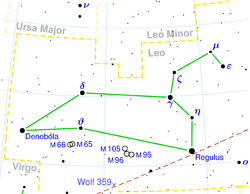Omicron Leonis
| Observation data J2000.0
| |
|---|---|
| Constellation | Leo |
| Right ascension | 09h 41m 09.03s |
| Declination | +09° 53' 32.30" |
| Apparent magnitude (V) | +3.52[1] |
| Characteristics | |
| Spectral type | F8-G0III + A7m[2] |
| U−B color index | 0.21[1] |
| B−V color index | 0.49[1] |
| Absolute magnitude (MV) | +0.51[5] |
Myr | |
| ο Leo Ab | |
| Mass | 1.87±0.01 M☉ |
| Radius | 2.2±0.3 R☉ |
| Luminosity | 15.4±1.0 L☉ |
| Temperature | 7,600±400 K |
HR 3852, SAO 98709 | |
| Database references | |
| SIMBAD | data |
Omicron Leonis (ο Leonis, abbreviated Omicron Leo, ο Leo) is a
It consists of a binary pair, designated Omicron Leonis A and an optical companion, Omicron Leonis B.[6] A's two components are themselves designated Omicron Leonis Aa (officially named Subra /ˈsuːbrə/, the traditional name for the system)[7][8] and Ab.
Nomenclature
ο Leonis (Latinised to Omicron Leonis) is the star's Bayer designation. The designations of the two constituents as Omicron Leonis A and B, and those of A's components—Omicron Leonis Aa and Ab—derive from the convention used by the Washington Multiplicity Catalog (WMC) for multiple star systems, and adopted by the International Astronomical Union (IAU).[9]
It bore the traditional name Subra, from the Arabic زبرة zubra (upper part of the back), originally applied to Delta and Theta Leonis.[10]
In 2016, the
Properties
The two members of the spectroscopic pair have similar brightnesses, but are very different stars: the primary is given the
The visible companion, component B, is a much fainter star that has increased its separation from about an
References
- ^ Bibcode:2002yCat.2237....0D.
- doi:10.1086/342942.
- ^ S2CID 18759600.
- ^ S2CID 120280239.
- S2CID 119257644.
- ^ a b "Washington Double Star Catalog". United States Naval Observatory. Archived from the original on 14 February 2011. Retrieved 2 January 2018.
- ISBN 978-1-931559-44-7.
- ^ a b "Naming Stars". IAU.org. Retrieved 16 December 2017.
- arXiv:1012.0707 [astro-ph.SR].
- ^ Jim Kaler's website: http://stars.astro.illinois.edu/sow/subra.html (online 6th Sep 2015)
- ^ IAU Working Group on Star Names (WGSN), International Astronomical Union, retrieved 22 May 2016.
- ^ "WG Triennial Report (2015-2018) - Star Names" (PDF). p. 5. Retrieved 2018-07-14.
- S2CID 244398875. Gaia DR3 record for this source at VizieR.
External links
- Omicron Leo/Subra in Kaler Stars [1]
- Subra (HIP 47508) Relates to the A star, Subra-B
- Subra - Omi Leonis brief data.

